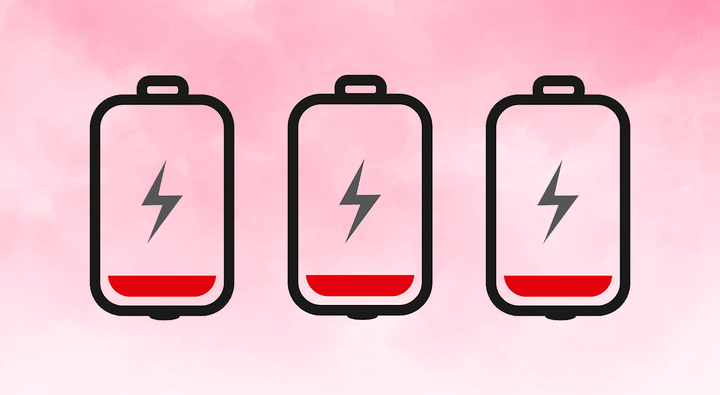My phone battery hovers precariously at 20%; the result of all those hours spent on WhatsApp. As I move it into low power mode, attempting to conserve the battery by accessing only the phone’s most basic functions, I wonder: should we be applying the same rule to our own lives?
That is the view of Gretchen Rubin. I listened in to the New York happiness expert’s podcast as she chatted to her sister about the idea of adopting a low power mode for ourselves: powering down a little if we feel overwhelmed; saying no to the endless stream of requests and demands; doing just what needs to be done, in order to conserve our energies. “Energy is precious,” Rubin tells HuffPost UK. “Whenever we can conserve it, we can use it in another area of our lives—an area that’s more valuable to us.”
It feels like the analogy that might help us find balance in busy lives; a strategy to carry into the new year. How many times have you found yourself saying yes to everything, only to end up juggling a drink with an old work colleague, catch up with your mum, and the planning for a dinner you agreed to host on the weekend.
Just as your phone battery drains when you’re flicking relentlessly between WhatsApp, Twitter and Instagram, so the same happens to energy levels when we never give ourselves a break to just breathe.

Rubin goes into low power mode (LPM) when she’s on holiday. “There’s no one right way or wrong way to do it,” she says. “For some people, it’s useful to switch off completely during holidays. For others (like me) trying to switch off completely creates more stress than it relieves – I find it more relaxing to go into LPM, so I stay connected, stay in the loop, but just in a far less active way.”
Rubin says she will check emails occasionally and do an hour or two of work – but not at the pace she would usually push herself. She also goes into LPM when she’s in a time of great change. When she has a book that’s about to hit the shelves, she doesn’t make lunch dates or plans with friends – she reduces the number of events in her social calendar to get prepped for what’s coming up.
Fancy giving it a go? Here’s how to get started:
Decide What Low Power Mode Looks Like For You
It’ll be unique to each individual – while one person may stop saying yes to every social invitation, for another it may be about not logging into work emails after dinner. Think about what aspects of your life you can remove or reduce that may give you headspace. “Decide for yourself what you will and won’t do when you’re in LPM,” says Rubin. “Do you check your email over the weekend? Think about what you could ditch.”
Try To Keep Away From Distractions
Focus on one thing at a time, suggests Chloe Brotheridge, hypnotherapist and coach at Calmer You, and author of ‘The Anxiety Solution’. This means staying away from distractions – “They create more stress and overwhelm you as you battle to keep your focus,” she says. “How can you arrange your environment so that it’s clutter-free? Can you take yourself away to a quiet cafe to do some work away from your colleagues?”
“Focusing on a single thing at a time is a good way to start when going into low-power mode."”
Tell People What You’re Doing To Manage Expectations
If you decide that you need to temporarily reduce the number of wine dates you have with pals, let them know that you’re going to be taking some time out so they don’t worry about why you’re not in touch. “Tell people that you’re in LPM so that they know what to expect from you,” says Rubin.
Prioritise Your To-Do List
Some of us love to get everything out of our brains and onto a to-do list – only to then feel daunted by its length. But is it all urgent? Do you actually need to research 2019 holiday destinations now? “Your to-do list can be a distraction - so instead, write the highest priority task on a piece of paper and focus exclusively on that,” advises Brotheridge. “Once you’ve done that, write another task on another sticky note and focus just on that. Some people find it helpful to schedule their tasks into their diary hour-by-hour; you use up less energy deciding what to do next and you’ll be more productive.”
Work Out How Long You’ll Need For A Recharge
Going into low power mode for one weekend might be enough to help you feel refreshed. Or, you might need a few weeks downtime in order to recuperate some energy from a particularly busy time. “Decide approximately how long you’ll be in LPM,” advises Rubin. “If you want to be in LPM indefinitely, you’ve actually decided to change your level of work engagement. That’s fine, as long as you realise that’s what you’re doing.”
Ideas For Going Into Low Power Mode
:: Only respond to texts/messages that have a purpose, rather than general chit chat.
:: Turn off notifications for certain apps on your phone, so you only get alerted for phone calls or text messages, for example.
:: Avoid saying yes to every social event, particularly ones you aren’t that enthused about anyway.
:: Don’t work out of hours if it isn’t necessary.
:: Reduce the amount of time you spent scrolling aimlessly on your phone.
:: Don’t stress yourself out making fancy pants meals, if you can make a quick and easy dinner without the hassle – unless you find it relaxing.
:: Make time for basic self-care that you enjoy, whether that be taking a bath, reading a book, or getting an early night.
:: Try to live in the moment. Don’t worry about an occasion that might be happening in three weeks’ time. Take each day as it comes.
